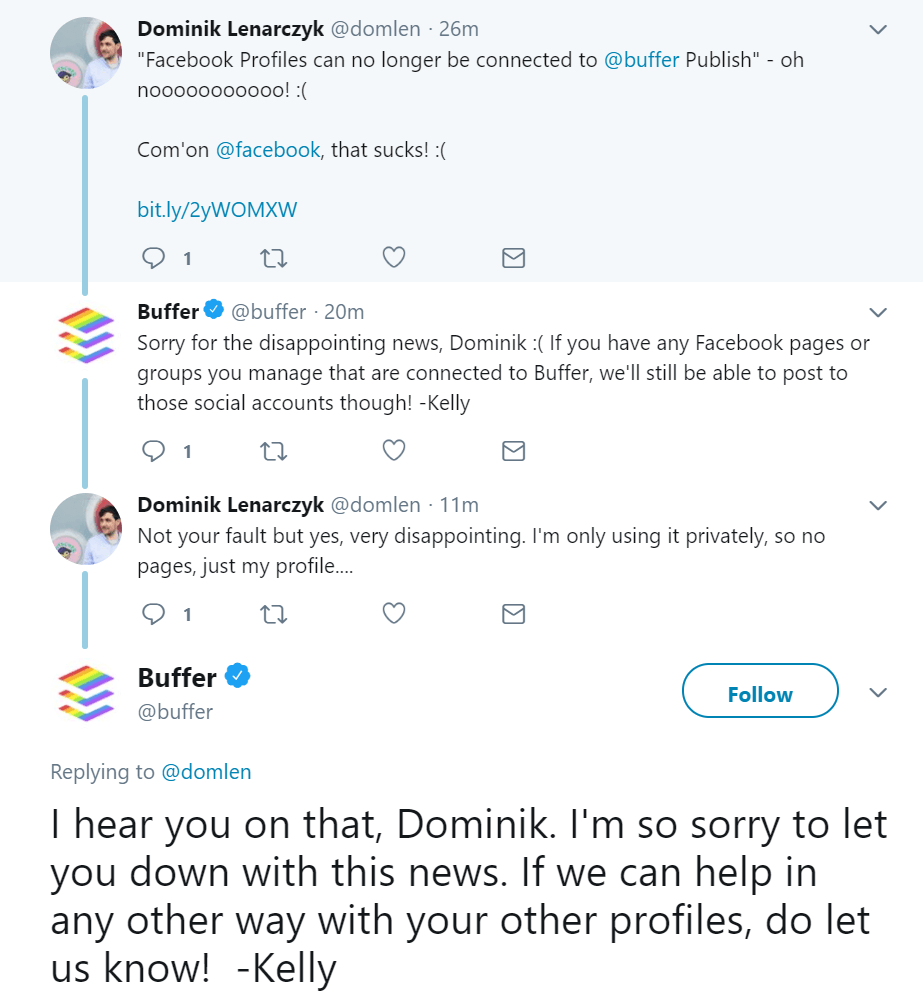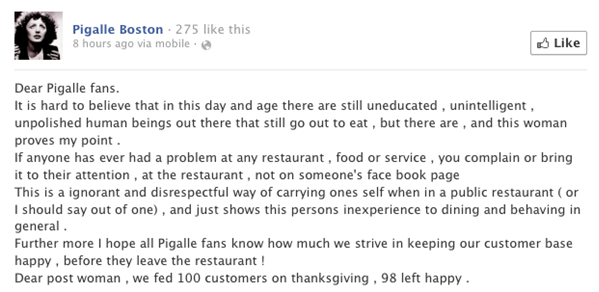It happens to the best and worst of us. You’ve just fired up Hootsuite or opened your email, and the biggest item waiting for you is an angry customer rant. Things have gone wrong, and now you have to try and make them right.
No matter what, it’ll happen to every business. However, the make-or-break moment comes when you respond. You’ve got the potential to save a relationship and create positive, digital word-of-mouth, or you can get accusatory and ruin it all — plus maybe lose a few extra fans who see your angry rant.
Negative reviews can become an overall positive thing for your business from both customer service and internal growth perspectives. This article will talk about how you can achieve both, starting with the response and then moving on to the big takeaways your business should look for consistency.
Take a minute
It is tough to see a negative review. It can hurt feelings and cause anger, making us want to lash out whether or not the review is justified. When you see something negative, take note and plan to deal with it, just not right away. Give yourself a moment to calm down so you can approach this with a level head.
The amount of time you can give yourself depends on the platform where the review was provided. Things like Amazon, review sites and your pages can give you up to a day or so. Unfortunately, social media requires a much quicker response. You want to help manage and move the conversation to a resolution before others pile on or before subsequent comments devolve into personal attacks.
Here’s what not to do. Source
Goal: Calmly put yourself in the customer’s shoes so you can respond to them as quickly as you would want to be responded to on that platform.
Listen and be responsible
Now that you’ve got a handle on your emotions, check out the disparaging review again. Do your best to listen to the customer review and see if it seems legitimate. Remember, people are talking about an overall experience with your products or services, which happens under circumstances that are specific to them.
See if you can understand what they’re saying, why they are saying it, and what went wrong. Sometimes a review is about a product failing, and other times there is something else lurking under the surface. Being open to feedback and honest about the situation can help you create a positive connection with the customer, even if they’re upset.
And, if you can see that the fault is yours, take responsibility in the very first instance. Before you explain or ask questions or anything else, show the customer that you’re there and willing to work with them. Start with something like “Oh no, we’re sorry that happened. Can you tell us a little more about it?”
 Open hostility makes it hard to want to eat here, even if the owner is right. (Source)
Open hostility makes it hard to want to eat here, even if the owner is right. (Source)
Goal: Start a conversation to let people know you care. This is the first step in turning a negative review into a positive experience for that customer to keep them satisfied.
Don’t Ignore
Some may look at a negative review and just decide to ignore it. Unfortunately, this doesn’t make things go away. It even can worsen the situation.
Ignoring a negative review leaves the concern unanswered. That can easily cost you the customer who complained. If someone else has a similar experience and this review pops up in their search results for the issue, they will also see that the problem is unresolved. It might have cost you two customers now.
Each new search is a potentially lost customer. That’s reputational damage that doesn’t need to occur at all.
Try to address it
You can’t solve everything or please everyone. If someone is firmly in the camp of your business is not being able to fix it or make them happy, thank them and move on to the next comment. That’s all you can do for that individual.
If, however, the person making the complaint seems open to resolution, start that conversation. Ask what you can do or try to provide a resolution that helps them. Resolutions often need to be two-fold, addressing both process failures and personal resolution:
- Address the root issue. Discuss how to solve their problem or what you’ll do to prevent this from happening in the future. Typically, this will be about your quality assurance, such as promising to review products and orders or updating your website’s messages that promise certain shipping dates. You can even share information such as you’re moving to a guaranteed-quick fulfillment partner. On the damage-control coin, this is the process side.
- Address the pain that caused them to reach out. You won’t always be able to address the cause of the problem with a customer, but you can tackle their pain. Sometimes it’s as simple as sending a replacement or something in the correct size. Other times, you might need to send a coupon, refund shipping costs, or replace a purchase with something different. This is the personal side of damage control.
Customer support can’t change everything, but you can explain business decisions. (Source)
When possible, make commitments others can see. On Twitter or Facebook, for example, you can start off by responding: “Let’s make that right by getting you a replacement.” This shows everyone else who sees the post that you’re willing to respond and make things right.
Your customers want to be treated “right,” and they use that to guide their purchase decisions. Customer service directly impacts customer loyalty, and that’s true in everything from your ecommerce store to how people pick health care plans.
Goal: Turn the initial negative review into a positive one. People tend to read reviews as well as responses to them, and 68% of respondents say positive reviews make them more likely to work with a business, while 40% say negative reviews make them turn away.
Respond and pivot
In the digital customer service age, one side note is very important: you want to get people into private channels before talking specifics. You need to move into DMs or email or chats whenever someone needs an item replaced because you don’t want any of their personal details floating around on the Internet.
This protects both your business and your customers.
 Keep personal details protected, but don’t forget to keep replying if they’re talking. (Source)
Keep personal details protected, but don’t forget to keep replying if they’re talking. (Source)
A secondary benefit is that it can influence others who see the interaction. They may view you as taking the problem more seriously and as being more helpful by giving that customer personal attention.
Create a long-term learning plan
Generating a 5% increase in customer retention can increase profitability by 25% up to as much as 95%. Customer service is your only option to turn a bad review into a positive experience and retain that customer. If you don’t try or don’t take steps to prevent it from happening again, you can kiss retention and related profitability goodbye.
That means you need a full plan on how to turn these interactions into wins in the short-term. Long-term, you want a way to ensure that feedback gets to the appropriate people to make a change in your business. This feedback loop is important for retaining customers.
We recommend that your customer service team document all reviews, whether they’re posted on a website, called, emailed, or sent to you via social media. Separate out the positive and negative reviews, then look for patterns.
If 90 people love your purple coloring and three don’t, then it is likely a personal taste issue and not a reason to change your production line. However, if 100 people say that it falls apart after a month and you end up sending them replacements, then you’re probably going to want to look at changing production.

Plans also help you understand how to show you can help in other ways. (Source)
Goal: Gather as much data as you can to identify common trends. Resolving these concerns before they get to the customer can improve overall satisfaction rates.
And don’t forget, your partners may have more data for you to use. Order fulfillment companies track a wide range of order data, so you might realize that most of your returns come from a certain area, during a certain time of the year, or were impacted by the same event — such as an early cold snap either delaying deliveries or making your Bermuda shorts less comfortable to wear.
The Positive Undercurrent
We discussed some of the main ways to handle a critical review to turn it into a positive from a PR perspective. There are also some benefits to the underlying nature of your business.
Negative reviews give us perspective. They show what might not be working or what promises may be confusing — sometimes a complaint isn’t about you not delivering, it’s about the customer not understanding you.
 You also have a chance to turn a minor negative into a heart (or tummy) warming experience. (Source)
You also have a chance to turn a minor negative into a heart (or tummy) warming experience. (Source)
Studying reviews gives you a chance to identify areas where your business is underperforming. That long-term learning plan we just touched on gives you a guide for addressing these areas. Taking the time to adjust and adapt can improve how customers see you and grow your revenue.
It’s hard to see and hear negative things about us and our businesses. However, it is also a chance to grow and become what’s desirable. At the end of the day, an ecommerce business succeeds when it gives customers what they want.
Negative reviews are one clear path to discovering customer expectations and ways to meet them.
Published July 19, 2018














